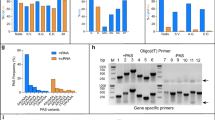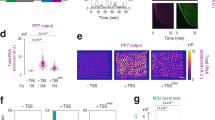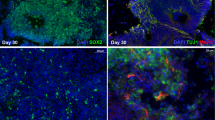Abstract
The positions of nucleotide sequences involved in the stage-and/or tissue-specific expression of structural genes in higher organisms are largely unknown. One might predict, however, that closely linked genetic loci which are not coordinately controlled will contain regulatory sequences in close proximity to the respective coding regions. During the third instar of larval development in Drosophila melanogaster, the hormone ecdysterone augments the expression of several genes in fat body tissue, one of which is the structural gene coding for larval serum protein-2, LSP-21–5. Although LSP-2 transcripts are detected only in third-instar larval fat bodies, a genomic clone containing the LSP-2 gene (clone 104) hybridizes to poly(A)+ RNA prepared from other tissues. We have now analysed clone 104 for other coding regions. Three transcripts, designated T1, T2 and T3, hybridize within the 12.5 kilobases (kb) of DNA flanking the 5′ end of the LSP-2 coding region. The T1 coding region is separated from the 5′ end of the LSP-2 coding region by no more than 2.5–3.5 kb. In contrast to the dramatic increase in the level of LSP-2 transcript induced by ecdysterone in third-instar larval fat bodies, the T1 transcript remains below the detectable level, indicating that expression of the two coding regions is not coordinately regulated.
This is a preview of subscription content, access via your institution
Access options
Subscribe to this journal
Receive 51 print issues and online access
$199.00 per year
only $3.90 per issue
Buy this article
- Purchase on SpringerLink
- Instant access to full article PDF
Prices may be subject to local taxes which are calculated during checkout
Similar content being viewed by others
References
Lepesant, J. A., Kejzlarova-Lepesant, J. & Garen, A. Proc. natn. Acad. Sci. U.S.A. 75, 5570–5574 (1978).
Levine, M., Garen, A., Lepesant, J. A. & Kejzlarova-Lepesant, J. Proc. natn. Acad. Sci. U.S.A. 78, 2417–2421 (1981).
Lepesant, J. A. et al. J. molec. appl. Genet. (in the press).
Roberts, D. B., Wolfe, J. & Akam, M. E. J. Insect Physiol. 23, 871–878 (1977).
Jowett, T. & Postlethwait, J. H. Nature 292, 633–635 (1981).
Berk, A. J. & Sharp, P. A. Cell 12, 721–732 (1977).
Levine, M. thesis, Yale Univ. (1981).
Hereford, L. M., Osley, M. A., Ludwig, J. R. II & McLaughlin, C. S. Cell 24, 367–370 (1981).
Snyder, M., Hirsh, J. & Davidson, N. Cell 25, 165–178 (1981).
Hirsh, J. & Davidson, N. Molec. cell. Biol. 1, 475–485 (1981).
Hynes, N. E., Kennedy, N., Rahmsdorf, U. & Groner, B. Proc. natn. Acad. Sci. U.S.A. 78, 2038–2042 (1981).
Maniatis, T. et al. Cell 15, 687–701 (1978).
Tabak, H. F. & Flavell, R. A. Nucleic Acids Res. 5, 2321–2332 (1978).
Thomas, P. S. Proc. natn. Acad. Sci. U.S.A. 77, 5201–5205 (1980).
Author information
Authors and Affiliations
Rights and permissions
About this article
Cite this article
Yedvobnick, B., Levine, M. The LSP-2 gene and a 5′ flanking sequence are independently expressed in Drosophila melanogaster. Nature 297, 239–241 (1982). https://doi.org/10.1038/297239a0
Received:
Accepted:
Issue date:
DOI: https://doi.org/10.1038/297239a0
This article is cited by
-
AT-rich linkers in long range organisation of Drosophila DNA
Molecular and General Genetics MGG (1985)



